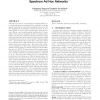Free Online Productivity Tools
i2Speak
i2Symbol
i2OCR
iTex2Img
iWeb2Print
iWeb2Shot
i2Type
iPdf2Split
iPdf2Merge
i2Bopomofo
i2Arabic
i2Style
i2Image
i2PDF
iLatex2Rtf
Sci2ools
136
click to vote
MOBIHOC
2005
ACM
2005
ACM
Inducing spatial clustering in MAC contention for spread spectrum ad hoc networks
This paper proposes a new principle for designing MAC protocols for spread spectrum based ad hoc networks ? inducing spatial clustering in contending transmitters/receivers. We first highlight the advantages of spread spectrum in handling quality of service (QoS) requirements, enhancing energy efficiency, and enabling spatial multiplexing of bursty traffic. Then, based on stochastic geometric models and simulation, we show how idealized contention resolution among randomly distributed nodes results in clustering of successful transmitters and receivers, in turn leading to efficient spatial reuse. This motivates the central idea of the paper which is to explicitly induce clustering among contending nodes to achieve even better spatial reuse. We propose two distributed mechanisms to realize such clustering and show substantial capacity gains over simple random access/ALOHAlike and even RTS/CTS based protocols.We examine under what regimes such gains can be achieved, and how clustering a...
Better Spatial Reuse | Efficient Spatial Reuse | MOBIHOC 2005 | Spatial Clustering | Wireless Networks |
| Added | 24 Dec 2009 |
| Updated | 24 Dec 2009 |
| Type | Conference |
| Year | 2005 |
| Where | MOBIHOC |
| Authors | Xiangying Yang, Gustavo de Veciana |
Comments (0)

